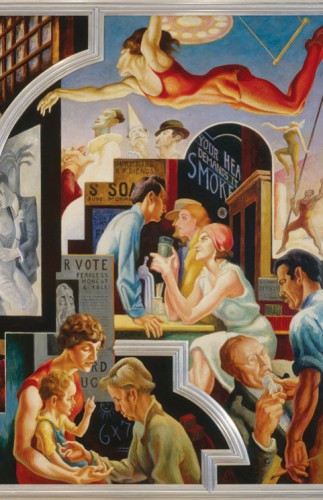
Thomas Hart Benton, detail, “City Activities with Dance Hall” from “America Today,” egg tempera with oil glazing over Permalba on a gesso ground on linen mounted to wood panels with a honeycomb interior, 1930–31 (The Metropolitan Museum of Art, New York, Gift of AXA Equitable, 2012)
Metropolitan Museum of Art, Gallery 746
1000 Fifth Ave. at 82nd St.
Daily through April 19, recommended admission $12-$25
212-535-7710
www.metmuseum.org
Several years ago, I was giving a friend a tour of Midtown lobby art when I started to lead him into the AXA Equitable Center on Seventh Ave. between Fifty-First and Fifty-Second Sts. “Why are we going in here?” he asked, adding, “I worked here for six years.” We walked in and I pointed up at the walls, which contained Thomas Hart Benton’s swirling 1930-31 mural, “America Today.” Glancing around, he said, “I can’t believe I never noticed this before.” Upon recently encountering “America Today” at the Met — AXA donated the seminal work to the museum in December 2012 while undergoing renovations — I felt as if I’d never seen it before myself, even though I had marveled at its wonder dozens of times. It has been carefully reinstalled to its original dimensions, complete with zigzagging silver Art Deco elements cutting through each piece, as commissioned in 1930 by New School for Social Research director Alvin Johnson for a circular boardroom in Joseph Urban’s West Twelfth St. modernist building. You can now get up close and personal with Benton’s dramatic depiction of contemporary America, a country built by hardworking people as technology and industry grow at an unstoppable pace. Using egg tempera that he made himself with eggs given to him by the New School (in lieu of actual monetary payment), Missouri native Benton divided the work into ten panels, each one based on scenes he had witnessed during his travels across the country in the 1920s. “Every detail of every picture is a thing I myself have seen and known,” he said. “Every head is a real person drawn from life.” Among his models was one of his students, Jackson Pollock, who posed for several characters. The panels range from the futuristic “Instruments of Power” to the Jazz Age “City Activities with Dance Hall,” from the cotton-heavy “Deep South” to the fiery “Steel” and “Coal,” from “Outreaching Hands” grasping for more to “City Building,” with skyscrapers rising in the background while men toil in the foreground. In addition to being a dynamic piece of art, “America Today” serves as an important historical document, capturing a country obsessed with progress despite the coming Great Depression. Benton’s naturalistic flair and use of color, especially reds, which stand out in every panel, add dramatic impact and cinematic scope to his narrative of America’s resiliency and determination, a story that would be told very differently if Benton were around today to report on the state of things.

Thomas Hart Benton, “Outreaching Hands” from “America Today,” egg tempera with oil glazing over Permalba on a gesso ground on linen mounted to wood panels with a honeycomb interior, 1930–31 (The Metropolitan Museum of Art, New York, Gift of AXA Equitable, 2012)
“Thomas Hart Benton’s ‘America Today’ Mural” is supplemented with works that inspired Benton, including Pieter Bruegel the Elder’s “The Harvesters,” Giorgio de Chirico’s “Ariadne,” James Lesesne Wells’s “Builders,” Reginald Marsh’s “The Bowery,” and Grant Wood’s “The Midnight Ride of Paul Revere,” as well as other Benton paintings. There is also a very informative video presentation that follows the path of the mural from inception to installation at the Met. It’s quite a story, and quite a work.